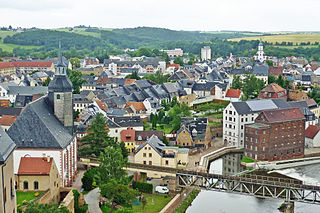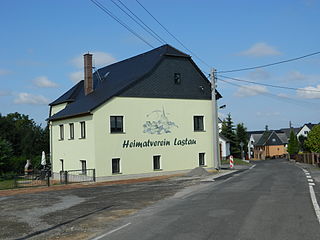
Colditz is a small town in the district of Leipzig, in Saxony, Germany. It is best known for Colditz Castle, the site of the Oflag IV-C POW camp for officers in World War II.

Anna Maria of Mecklenburg-Schwerin was a German noblewoman, a member of the House of Mecklenburg and by marriage Duchess of Saxe-Weissenfels.

Freyburg is a town in the Burgenlandkreis district, in Saxony-Anhalt, Germany. It is situated on the river Unstrut, 9 km northwest of Hanseatic Naumburg, 63 km from Leipzig and 231 km from Berlin. It is part of the Verwaltungsgemeinschaft Unstruttal.

Rochlitz is a major district town in the district of Mittelsachsen, in the Free State of Saxony, Germany. Rochlitz is the head of the "borough partnership Rochlitz" with its other members being the boroughs of Königsfeld, Seelitz und Zettlitz.

Seelitz is a municipality in the district of Mittelsachsen, in Saxony, Germany. It is part of the administrative partnership Verwaltungsgemeinschaft Rochlitz based in the eponymous town.

Augustus of Saxe-Weissenfels, was a Duke of Saxe-Weissenfels-Querfurt of the House of Wettin and administrator of the Archbishopric of Magdeburg.

Catherine of Henneberg was a Countess of Henneberg by birth and from 1347 by marriage Margravine of Meissen, Landgravine of Thuringia, etc. She was the wife of Margrave Frederick the Severe of Meissen. Via her, the House of Wettin inherited her father's Franconian possessions.

Dohna Castle on the once important medieval trade route from Saxony to Bohemia was the ancestral castle seat of the Burgraves of Dohna. Of the old, once imposing double castle only a few remnants of the walls remain. The ruins of the old castle are located on the hill of Schlossberg near the subsequent suburb of the town of the same name, Dohna, in the district of Sächsische Schweiz-Osterzgebirge in Saxony, Germany.

Pillnitz Castle is a restored Baroque palace at the eastern end of the city of Dresden in the German state of Saxony. It is located on the bank of the River Elbe in the former village of Pillnitz. Pillnitz Castle was the summer residence of many electors and kings of Saxony; it is also known for the Declaration of Pillnitz in 1791.

Kriebstein Castle is a castle in Kriebstein near the town of Waldheim in the German state of Saxony.

Altzella Abbey, also Altzelle Abbey, is a former Cistercian monastery near Nossen in Saxony, Germany. The former abbey contains the tombs of the Wettin margraves of Meissen from 1190 to 1381.

The hunting lodge of Augustusburg was built from 1568 to 1572 above the town of the same name on a hill called the Schellenberg on the northern edge of the Ore Mountains of Germany. The castle, which is visible from afar, is a local landmark. It lies about 12 kilometres east of the city of Chemnitz and about 21 kilometres southwest of Freiberg in the Free State of Saxony.

Stein Castle is a Saxon castle located southeast of Zwickau in the village of Stein in the municipality of Hartenstein on the rocky banks of the Zwickauer Mulde in the east German state of Saxony.

The Transylvanian Museum is a museum situated in Gundelsheim, Germany, dedicated to the protection, preservation and documentation of the cultural heritage of the Transylvanian Saxons and of their coexistence with the other Transylvanian ethnic groups in this multi-ethnic region.

Schloss Weimar is a Schloss (palace) in Weimar, Thuringia, Germany. It is now called Stadtschloss to distinguish it from other palaces in and around Weimar. It was the residence of the dukes of Saxe-Weimar and Eisenach, and has also been called Residenzschloss. Names in English include Palace at Weimar, Grand Ducal Palace, City Palace and City Castle. The building is located at the north end of the town's park along the Ilm river, Park an der Ilm. It forms part of the World Heritage Site "Classical Weimar".

Rochsburg Castle, which was probably founded in the late 12th century, stands on a rock spur, surrounded on three sides by the Zwickau Mulde river, above the eponymous town quarter in Lunzenau in Saxony. The medieval site and its division into the inner bailey, outer bailey and two zwingers is still easy to recognise. In its present appearance the schloss dates, however, to the Late Gothic and Renaissance periods. Its main construction phases date to 1470 and 1548; it is an important example of Renaissance architecture in Saxony. Over centuries the Rochsburg has formed the centrepiece in the Saxon district of Rochsburg.

Lastau is a village in Landkreis Leipzig, Saxony, Germany with approx. 222 inhabitants (2012). On 1 January 1994 it was incorporated into the town Colditz.

Mildenstein Castle, in German Burg Mildenstein, also called Schloss Leisnig, is located in Leisnig in Landkreis Mittelsachsen, Saxony, Germany. It is a property of the Free State of Saxony and is administrated by the company State Palaces, Castles and Gardens of Saxony.

Gymnasium St. Augustine in Grimma is the only regular gymnasium offering boarding in Saxony. It is heavily steeped in tradition as one of the foremost schools in the country. Founded in 1550 as one of the three Fürstenschulen in Saxony, it has prepared young people for university studies since then.





















